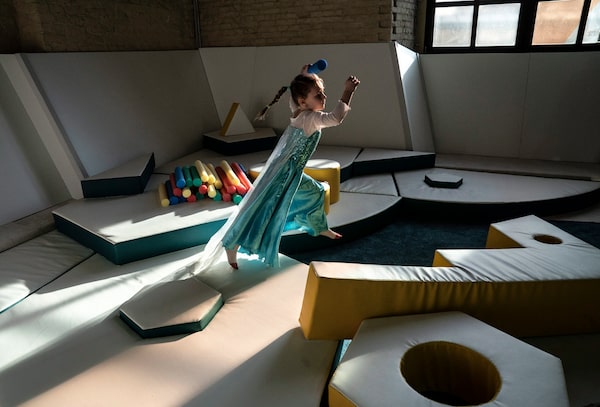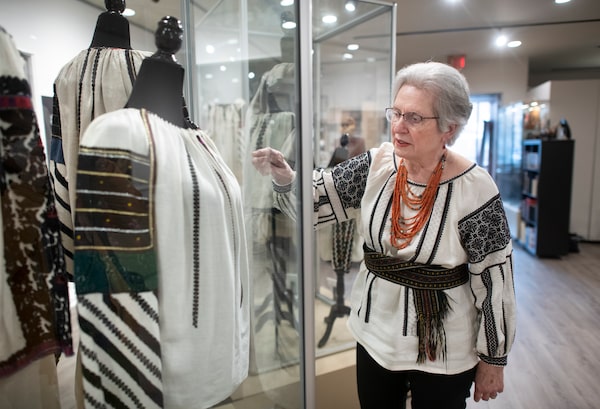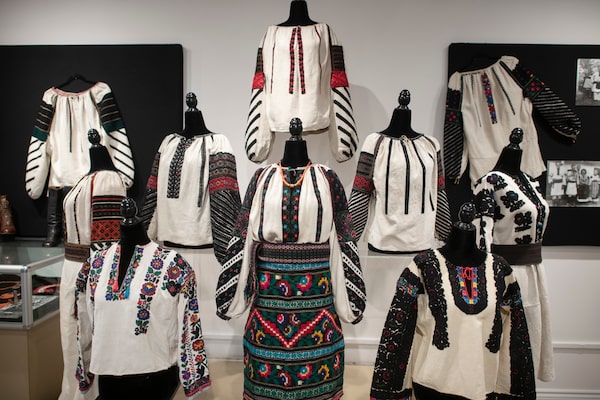
A visitor takes a photo of a painting by Maria Primachenko, a renowned Ukrainian village folk art painter, in Mystetsky Arsenal art gallery in Kiev, Ukraine, Feb. on 11, 2016.Efrem Lukatsky/The Associated Press
When Russian forces invaded Ukraine, staff at Taras Shevchenko National Museum in the country’s capital rushed to move prized collections into hiding. Mykhailo Zubar is among the country’s cultural employees who are fighting to protect the country’s priceless historical artifacts. But the situation is as challenging as it is risky.
“The evacuation system in our country is largely based on outdated and abstract documents, many of which were written during the Soviet era and in fact have never been tested in practice,” Zubar told the Globe through an e-mail in Ukrainian. “As far as I know, many museums did not even have packing materials.”
On social media, museum directors have described setting up barbed wire around museum facilities, while other cultural buildings are being used as temporary shelters for displaced residents. Staff are reportedly hiding the artifacts in pre-arranged locations or bringing them across borders when possible.
Timing is crucial. On Monday, Ukraine’s Ministry of Foreign Affairs confirmed that just 80 kilometres north of the city, the Ivankiv Museum, which held precious archeological and folk items, had been destroyed. Lost in the blaze were about 25 works, widely considered priceless national treasures, by folk artist Maria Pryimachenko.
The destruction has drawn the attention of international cultural bodies and has prompted local leaders to warn of what could come next. In a Facebook post, Vlada Litovchenko, director of the Vyshhorod Historical and Cultural Reserve near Kyiv, decried the attack, warning that numerous historical and architectural monuments and archaeological sites were “under threat of artillery shelling and uncontrolled movement of heavy military trucks.”

A girl plays in a children's room in the Mystetskyi Arsenal National Art and Culture Museum Complex in Kyiv, Ukraine, on Jan. 12, 2020.Evgeniy Maloletka/The Associated Press
The destruction of these artifacts has been decried as an attack on democracy, and amounts to a sort of cultural cleansing, said Jeremy Maron, a curator of genocide content at the Canadian Museum of Human Rights in Winnipeg.
“Putin views Ukraine not as an independent nation, but as a part of Russia that was stolen from Russian control. In his perspective, it seems like there is no such thing as Ukrainian culture, so the cultural artifacts are fake evidence of the fake Ukrainian culture,” Maron said.
Cultural bodies including UNESCO have condemned the attacks on cultural sites and the danger posed to museum workers. Ukraine is home to seven UNESCO world heritage sites, including the Saint Sophia Cathedral in Kyiv, which contains unique 16th-century mosaics and frescoes, and Kyiv-Pechersk Lavra, a monastery founded in 1051.
This week’s Russia-Ukraine conflict evokes a history of tension in the Russian ballet world
Yet, Russia seems to have significant power over the world’s cultural sites. Last summer a Russian Federation diplomat was elected chairperson of the World Heritage Committee. Russia is one of 21 countries currently serving a term on the UNESCO body. In July, 2021, the committee chose Kazan, a city in southwest Russia, to host this year’s annual session where the list of new World Heritage Sites is approved. The organization has not yet confirmed whether the event, due to take place this June, will still go forward.
As a signatory of the 1954 Hague Convention for the Protection of Cultural Property, Russia is legally obligated to protect heritage, said Christina Cameron, Canada Research Chair on Built Heritage. Though “in the heat of war, this is often disregarded,” she says, citing recent armed conflicts in the Middle East which have led to the destruction of some of the world’s oldest historic sites, including the destruction of the ancient city of Palmyra in Syria by the Islamic State.
The destruction of historical artifacts in Ukraine during the Russian invasion has drawn the attention of international cultural bodies, and three Canadian museums are warning about what could come next.
However, there may be some retribution in the case of the destruction of cultural items, Cameron said. In 2012, the International Criminal Court in The Hague found a militant guilty of a war crime for his role in the destruction of nine mausoleums in Timbuktu, Mali. He was sentenced to nine years in prison.
For those Ukrainian artifacts that cannot be recovered, one Canadian institution is hoping to help fill the gaps. Daria Diakowsky, president of the Ukrainian Museum of Canada, said her institution is already planning to repatriate some of its own museum pieces to sites that lost their collections.
“We obviously do not have the quantity or the quality of artifacts that are available there. But we are willing to repatriate any of the artifacts that they would find useful.”

Fred Lum/The Globe and Mail

Above: Daria Diakowsky, president of the Ukrainian Museum of Canada. Below: Exhibits of Sorochka and vyshyvanka from the Borshchiv region in Ukraine.Fred Lum/The Globe and Mail
After Russia, Canada has the world’s second-largest Ukrainian diaspora – 1.3 million – of which the majority are located in Manitoba, according to the 2016 census.
The Manitoba Museum in Winnipeg’s chief executive, Dorota Blumczynska, said Canadian institutions have a responsibility to acknowledge global conflict – not just in Ukraine, but also in other places in the world that have also been ravaged by war. These places include Afghanistan, Yemen, Sudan, Ethiopia, Venezuela and Syria, where conflict continues to put lives and cultural monuments in danger.
“This feels like repeated history in so many ways,” she said.
In addition to her role at the Manitoba Museum and as a Canadian Museums Association board member, Blumczynska also has a personal connection to the current situation in Ukraine: In 1988, Blumczynska’s family left occupied Poland, and at the age of seven she became a refugee.
“One of the most terrible things that a refugee can suffer is the feeling that they’ve been forgotten,” Blumczynska said. “For Canada and for the world, the task is to ensure that we bear witness and that we never forget; that this becomes part of our collective memory.”
Sign up for The Globe’s arts and lifestyle newsletters for more news, columns and advice in your inbox.
 Irene Galea
Irene Galea